Giuseppe VERDI (1813-1901)
A conspectus of his
life and a review of the audio and video
recordings of his works - Robert Farr
Introduction
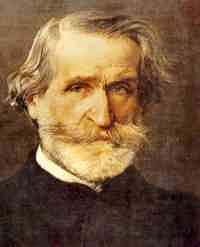 Later
in his life, Giuseppe Verdi came to
be called Ďthe glory of Italyí. After
his death, the now unified nation of
Italy mourned as one. Twenty thousand
people lined the streets to pay their
respects as the composerís remains were
carried in a solemn procession through
Milan to their final resting place.
The crowd, aided by the chorus of La
Scala under Toscanini, sang a moving
rendition of Va pensiero, the
chorus of the Hebrew slaves from the
opera Nabucco It was this opera,
composed sixty years before, which set
Verdi on the path to unparalleled national
and international acclaim. He composed
operas for all the major cities of Italy
and for London, Paris, Cairo and St
Petersburg. He played a significant
part in the creation of the nation we
now know as Italy and served in that
countryís first national Parliament.
Later
in his life, Giuseppe Verdi came to
be called Ďthe glory of Italyí. After
his death, the now unified nation of
Italy mourned as one. Twenty thousand
people lined the streets to pay their
respects as the composerís remains were
carried in a solemn procession through
Milan to their final resting place.
The crowd, aided by the chorus of La
Scala under Toscanini, sang a moving
rendition of Va pensiero, the
chorus of the Hebrew slaves from the
opera Nabucco It was this opera,
composed sixty years before, which set
Verdi on the path to unparalleled national
and international acclaim. He composed
operas for all the major cities of Italy
and for London, Paris, Cairo and St
Petersburg. He played a significant
part in the creation of the nation we
now know as Italy and served in that
countryís first national Parliament.
During his later life, and since his
death, Verdiís operas have formed the
backbone of the repertoire of the worldís
opera houses, both great and small.
All his 28 operas are available in well-recorded
studio versions featuring the great
singers of their generation. Many are
also available in video format, increasingly
in varied production styles. Over the
coming months I intend to survey Verdiís
life and the available recordings of
his works. Although some of the lesser
known of Verdiís operas, particularly
those from his earlier earliest compositional
periods, have few recordings his most
popular operas have many. In dealing
with the latter I shall have to make
personal choices as to which I refer
and recommend. Where a recording has
a full review on Musicweb-International.com
a link reference will be provided. Many
of these reviews will be by colleagues
and their opinions may differ from mine.
I will not include references to pirated
live recordings, many in poor sound,
but I will refer to legitimate recordings
of live performances.
The conspectus will appear on
the Musicweb-International.com
classical reviews site at http://www.musicweb-international.com/Current_Reviews.htm
in the following four parts
over the remainder of 2006 under the
title Verdi conspectus.
PART 1. Verdi's background,
getting established and first five
operas from Oberto (1839)
to Ernani (1844)
PART
2. Verdiís Ďanni de galeraí
(galley years). The ten operas
from I due Foscari (1844) to
Luisa Miller (1849)
Forthcoming:
PART
3. Verdiís middle period.
The eight operas from Stiffelio (1850)
to Un ballo in Maschera (1859)
PART
4. Verdiís great final
operas from La Forza del Destino
(1862) to Falstaff (1893) and
including the revisions of Macbeth
and Simon Boccanegra. Also
appendices covering The Requiem, collections
of arias, overtures and choruses.
PART 1. Verdi's
background, getting established and
first five operas from Oberto
(1839) to Ernani (1844)
Giuseppe Verdi was born in October 1813
in La Roncole, a hamlet of one hundred
souls in the plain of the river Po.
Situated in the Duchy of Parma the area
was under the rule of Napoleonic France.
A year after Verdiís birth Russian Cossacks,
allied to Austria, drove out the French
and Parma, like much of what we now
call Italy, came under Austrian control.
The fight for an independent and unified
Italy was later to play an important
part in Verdiís personal and compositional
life.
Verdi drew many short straws in his
long life and these did much to mould
his determined and implacable character.
He carried grudges, was often irascible
and later in life he was prone to exaggerate
earlier personal circumstances and happenings
to give them added colour. He was certainly
not, for example, born into an illiterate
peasant family. His father, Carlo, was
a small landowner and trader and was
literate. Carlo sought education for
his son and by the age of four the young
Giuseppe had begun instruction from
the local priests. 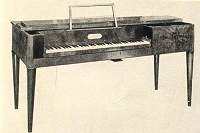 By
the age of eight his aptitude for music
was obvious and his father bought him
a battered spinet. This was rebuilt
free of charge by a local craftsman
impressed by the boyís musical skill
that enabled him to substitute as organist
in the local church. The spinet is now
in the museum of La Scala, Milan.
By
the age of eight his aptitude for music
was obvious and his father bought him
a battered spinet. This was rebuilt
free of charge by a local craftsman
impressed by the boyís musical skill
that enabled him to substitute as organist
in the local church. The spinet is now
in the museum of La Scala, Milan.
In 1823, at age eleven, Verdi entered
the Ďgiannasioí in nearby Busseto, a
town of around two thousand. He lodged
with the local cobbler there for seven
years. During this time he earned money
towards his fees by playing the organ
at Roncole each Sunday and on Feast
days. He claimed to have frequently
walked barefoot the three miles from
Busseto to save his shoe leather. The
young boy was not wholly alone in Busseto.
He came under the eye of Antonio Barezzi,
a wealthy local merchant known to his
father and who was patron of the local
orchestra that met in his house. As
well as formal education at school,
the young Giuseppe began lessons with
Ferdinando Provesi, maestro di cappella
at the local church, and also director
of the local music school and Philharmonic
society. Provesi was also a free thinking
Republican and radical. By the age fifteen
Verdi was conducting the local orchestra
and composing marches as well as arias,
duets, concertos and variations on themes
by famous composers. In all but name
he was Provesiís number two.
Having taught music to Barezziís children
Verdi moved in to lodge with the family
and fell in love with Margherita the
elder daughter, seven months his junior.
Such was his talent that it was hoped
that a scholarship would be granted
for him to study in Milan. This was
eventually forthcoming in 1833. To avoid
the waste of a year Barezzi guaranteed
financial support for the first year
and Verdi applied for admission to the
conservatory for 1832. He was refused
on the grounds that aged eighteen he
was four years beyond the normal age
and not a native of Lombardy-Venetia.
It was a rebuff that Verdi felt very
deeply and never forgot nor forgave.
Barezzi funded private study in Milan
with Lavigna who had been on the staff
at La Scala. Verdi later recalled that
Lavigna concentrated his tuition on
strict counterpoint with nothing but
canons and fugues. Verdi also attended
many performances at La Scala with a
ticket bought by Barezzi.
Verdi completed his studies in 1835.
That year Bellini died and Donizettiís
forty-seventh opera, Lucia di Lammermoor,
was premiered in Naples. Verdi returned
to Busseto. Provesi had died two years
before and Verdi was appointed maestro
di musica but not to succeed his mentor
in the church position. The secular
post involved conducting the concerts
of the Philharmonic society as well
as giving lessons at the music school
in vocal and keyboard music. The contract
was for nine years with a get-out clause
for either party after three. His position
secured, Verdi and Margherita were married
on 4 May 1836. They had two children,
a daughter Virginia Maria born in March
1837 and a son Icilio in July 1838.
Verdiís joy was short-lived as his daughter
died shortly after the birth of his
son.
Whilst Verdi performed his conducting
and teaching duties he composed marches,
overtures and a mass as well as a complete
set of vespers. Regrettably, in later
life Verdi ordered all his early compositions
to be destroyed. Meanwhile he was chaffing
at more ambitious plans including the
composition of an opera. He was in contact
with Milan and a series of letters indicates
the writing of Rocester to a
libretto by a Milanese journalist Antonia
Piazza. He tried to get this staged
in Parma without success. Encouraged
by friends in Milan, and with the help
of the librettist Temistocle Solera,
Verdi revised the work under the title
of Oberto conte di Boniface.
Determined to get the work staged
he resigned his Busseto post in October
1838 and left for Milan with his wife
and surviving child in February 1839.
In 1839, Milan was a city of one hundred
and fifty thousand people. It had been
ceded to Austria under the terms of
The Congress of Vienna in 1815 and was
the capital of the province of Lombardy-Venitia.
The Austrians kept a tight rein on the
local population. There were Austrian
soldiery everywhere and police vigilance
was unceasing as was the detailed activities
of the censor who determined the political
and religious suitability of any play
or opera proposed for presentation in
the cityís theatres. Few of the population
chafed at the situation. Any awareness
of the concept of a united Italy was
restricted to some exiles and literati.
The local aristocracy mingled with artistes
in their salons.
The La Scala theatre was run jointly
with a theatre in Vienna under the direction
of the impresario Bartolomeo Merelli,
who had written libretti for Donizetti.
Its operatic activities could be seen
as a tool of social control; an opiate
administered by a superb roster of singers
and dancers. It was in this milieu that
Verdi sought to establish himself as
an opera composer. He was twenty-six
years of age. By the same age Rossini
had had twenty-four of his operas staged
and was internationally acclaimed.
Merelli agreed to present Verdiís opera
in the spring of 1839 bearing all the
costs of the production himself, a high
risk with a composer untried before
the public. Due to illness among singers,
Oberto conte di Boniface,
No. 1 in the Verdi oeuvre
was not premiered until 17 November
1839. During the rehearsals Verdiís
second child, his son Icilio, died.
The opera was a big enough success for
Merelli to extend the number of scheduled
performances to fourteen that season
and twelve the next. He also sold the
score to Ricordi for the not inconsiderable
sum of two thousand Austrian Lire thus
recouping some of his investment. More
importantly for Verdi, Merelli contracted
the composer for three more operas to
be presented over the next two years
for a fee of four thousand Lire each
and half the money raised if the score
were sold. Oberto is also significant
insofar as it shows the composer drawn
from the start of his career to the
often-troubled father-daughter relationship
that was to occur overtly in so many
of his works.
Oberto missed out in the
seminal initial series of eight early
Verdi operas recorded by Philips between
1971 and 1979 under the stylish baton
of Lamberto Gardelli. Fortunately, Orfeo
took up the challenge with the same
conductor. Their recording of Oberto
features the incomparable Verdi
tenor Carlo Bergonzi and the veteran
Rolando Panerai in a well-sung 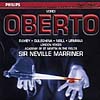 performance
(C 105842 H). This recording held the
fort until Philips returned to early
Verdi in 1998 and recorded the work
with Neville Marriner on the rostrum
(454 472-2). The recording features
Samuel Ramey as a sonorous, if not always
ideally steady Oberto, Maria Guleghina
as a generous-toned dramatic Leonora
and the then unknown Lithuanian Violetta
Urmana as a rich voiced Cuniza. Although
the tenor, Stuart Neil, is no match
for Bergonzi he sings with clean tone.
With the added advantages of an ideally
recorded sound and the inclusion as
appendices of music Verdi composed for
the La Scala revival in 1840, this performance
is clearly in first place. The La Scala
additions show something of a significant
step in compositional maturity on Verdiís
part compared
performance
(C 105842 H). This recording held the
fort until Philips returned to early
Verdi in 1998 and recorded the work
with Neville Marriner on the rostrum
(454 472-2). The recording features
Samuel Ramey as a sonorous, if not always
ideally steady Oberto, Maria Guleghina
as a generous-toned dramatic Leonora
and the then unknown Lithuanian Violetta
Urmana as a rich voiced Cuniza. Although
the tenor, Stuart Neil, is no match
for Bergonzi he sings with clean tone.
With the added advantages of an ideally
recorded sound and the inclusion as
appendices of music Verdi composed for
the La Scala revival in 1840, this performance
is clearly in first place. The La Scala
additions show something of a significant
step in compositional maturity on Verdiís
part compared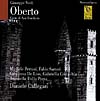 with the original score. What inner
creative force within Verdi, who had
undergone an overwhelmingly difficult
personal and professional period since
the first staging, enabled this step
up in quality of composition can only
be conjectured? (Note:
An Italian correspondent has kindly
brought to my notice a live performance
of Oberto available on both DVD and
CD involving Michele Pertusi, Fabio
Sartori and Dimitra Theodossiu conducted
by Daniele Callegari available on the
Fonè label and which is his preferred
version)
with the original score. What inner
creative force within Verdi, who had
undergone an overwhelmingly difficult
personal and professional period since
the first staging, enabled this step
up in quality of composition can only
be conjectured? (Note:
An Italian correspondent has kindly
brought to my notice a live performance
of Oberto available on both DVD and
CD involving Michele Pertusi, Fabio
Sartori and Dimitra Theodossiu conducted
by Daniele Callegari available on the
Fonè label and which is his preferred
version)
The first of the three contracted operas
to follow Oberto for La Scala
was initially to have been Il proscritto,
a libretto written by Gaetano Rossi
who had provided Rossini with the librettos
for Tancredi and Semiramide.
Before Verdi could commence work Merelliís
plans changed, he needed an opera buffa
and he passed several texts by the house
poet, Romani, over to Verdi. None appealed,
but with time short he settled on ĎIl
finto Stanislauí written twenty
years earlier, performed at La Scala
in 1818 and never revived. The title
of the work was changed to Un
giorno di Regno (A King for
a day), No. 2 in the Verdi oeuvre.
During the workís composition life for
Verdi was difficult. Money was short
and his wife pawned jewels to pay for
their lodgings. Always prone to psychosomatic
symptoms, Verdi suffered from a bad
throat and angina during the composition.
Then, in June 1840 on the feast of Corpus
Christi his beloved wife died of encephalitis.
To crown Verdiís misfortunes Un giorno
di Regno premiered on 5 September
1840 was whistled off the stage at its
first performance. The other five scheduled
performances were cancelled. Whilst
the composer recognised limitations
in his score he was pleased four years
later to note that what had been hissed
at La Scala was a great success in Venice.
In Naples in 1852 it played to full
houses 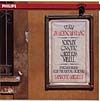 under
its earlier title. Although Verdi was
not to write another comic opera until
Falstaff in 1893, recent revivals of
Un giorno di Regno, one of which
I caught at the Buxton Festival. It
was thoroughly enjoyable and showed
the quality of the music being quite
worthy of a young composer and equal
to all but the best of Donizettiís comic
operas. The Italian company Cetra thought
the piece sufficiently strong to issue
a recording at the time of the fiftieth
anniversary of the composerís death
in 1951. Although re-issued by Warner-Fonit
it is not a serious competitor against
the 1973 recording in Philipsí early
Verdi series under Gardelliís sympathetic
baton and featuring José Carreras,
Jessye Norman and Fiorenza Cossotto
(422 429 2), which is thoroughly recommendable.
under
its earlier title. Although Verdi was
not to write another comic opera until
Falstaff in 1893, recent revivals of
Un giorno di Regno, one of which
I caught at the Buxton Festival. It
was thoroughly enjoyable and showed
the quality of the music being quite
worthy of a young composer and equal
to all but the best of Donizettiís comic
operas. The Italian company Cetra thought
the piece sufficiently strong to issue
a recording at the time of the fiftieth
anniversary of the composerís death
in 1951. Although re-issued by Warner-Fonit
it is not a serious competitor against
the 1973 recording in Philipsí early
Verdi series under Gardelliís sympathetic
baton and featuring José Carreras,
Jessye Norman and Fiorenza Cossotto
(422 429 2), which is thoroughly recommendable.
With his personal and professional life
in tatters, Verdi returned to Busseto
determined never to compose again. He
later said he spent his time reading
bad novels, surely self-flagellation
for a man who loved Shakespeare and
knew the works of Byron, Schiller and
Victor Hugo intimately. In reality Verdiís
life in this period was not that simple
or desperate. Merelli replaced the scheduled
performances of Un giorno di Regno
with further stagings of Oberto
a mere six weeks after the failed
opening night of the buffo work. As
I have noted, for these performances
Verdi composed entirely new music including
an entrance aria for Cuniza and two
duets. He made more extensive revisions
for performances given in January 1841
during the carnival season in Genoa
and which he had been commissioned to
mount personally. Regrettably none of
the music of these revisions survives.
After returning to Milan from Genoa,
Verdi met Merelli and returned the libretto
of Il proscritto and which the
impresario passed on to Otto Nicolai.
In return Merelli pressed on Verdi the
libretto of Nabucodonosor by
Temistocle Solera and which Nicolai,
then at the height of his Italian career,
had refused. Perhaps to satisfy Merelli,
Verdi read the libretto and was greatly
stimulated by it. Between the spring
and early autumn of 1841 the opera that
came to be called Nabucco,
No. 3 in the Verdi canon
was written. To Verdiís chagrin
its completion was too late for inclusion
in the La Scala season whose sequence
(Cartellone) had already been completed
and published. It took some vehement
correspondence from the composer before
the opera was premiered on 9 March 1842
in secondhand sets but with a first-rate
baritone and bass. Giuseppina Strepponi,
who was to be a great influence in Verdiís
life sang Abigaille, but was in poor
voice. The work was a resounding success
and although the season had only ten
days to run Nabucco was given
eight more times. The delighted Merelli
promptly scheduled a revival for the
following autumn when there were another
sixty-seven performances, breaking all
La Scala records. The chorus Va pensiero
was regularly encored with the Milanese
public, under Austrian occupation, clearly
identifying themselves with the oppressed
Hebrews of the story. It was a tenuous
start to the identification of Verdi
and his operas with the movement later
in the 1840s for the liberation and
unification of Italy called the Risorgimento.
For an opera of such pulsating rhythms,
glorious choruses and well-written parts
for principal soprano, baritone and
bass, Nabucco has curiously few
studio recordings. This may be due to
the impact of the outstanding first
stereo recording by Decca in 1965. It
was recorded in the companyís favourite
venue in Vienna with the orchestra and
chorus of the State Opera under the
baton of Lamberto Gardelli, an incomparable
Verdian who had learned his craft at
the feet of the great Italian opera
conductor, Tulio Serafin. Gardelliís
name will feature regularly in this
conspectus. His conducting of Deccaís
Nabucco, allied to the atmospheric
recording, the singing of the chorus
and the outstanding characterful portrayal
of Tito Gobbi in the name part and Elena
Suliotis as his supposed daughter, made
the recording one of the best of the
period. Suliotis aged 22 was unknown,
but her portrayal of Abigaille brought
big headlines. The role is dramatic
and strenuous. Her entrance recitative
cum aria Pride guerrier ranges
from B below middle C to B in alt and
combines declamatory and coloratura
styles. Suliotis attacks the aria and
the rest of the role with youthful vocal
abandon bordering on the reckless. It
is an approach which presages visceral
and dramatic excitement rather than
vocal beauty, but one which conveys
Abigailleís ruthless character and ultimate
softer plea for forgiveness to great
satisfaction. Gobbi, the odd raw patch
at the top of his voice apart, is as
characterful and vocally expressive
as one would hope. Carlo Cava as the
High Priest could be steadier whilst
the chorus is a match for any of Italyís
best.
EMI ventured into the studio in 1977
with Muti on the rostrum and a strong
trio of principals and a British session
chorus. Renata Scotto, although curdling
the odd high note, sings with typical
character as Abigaille. In the eponymous
role, Tunisian-born Matteo Manuguer ra
sings strongly whist Nicolai Ghiaurov
is the best High Priest on record. The
recording lacks the presence and frisson
of the Decca issue. Against the competition
DGís Berlin recording of 1982 with Sinopoliís
unidiomatic dissection of the score
is a non-starter against the competition.
Many will think that the role of Abigaille
would suit the Callas temperament. In
fact she only ever sang three performances
at age 25 in December 1949 at the Teatro
San Carlo, Naples under Vittorio Gui
and with a raw-toned Gino Bechi as Nabucco.
Recordings in rather poor sound have
appeared from time to time, the latest
(2006) from Membran Music (222387-311).
ra
sings strongly whist Nicolai Ghiaurov
is the best High Priest on record. The
recording lacks the presence and frisson
of the Decca issue. Against the competition
DGís Berlin recording of 1982 with Sinopoliís
unidiomatic dissection of the score
is a non-starter against the competition.
Many will think that the role of Abigaille
would suit the Callas temperament. In
fact she only ever sang three performances
at age 25 in December 1949 at the Teatro
San Carlo, Naples under Vittorio Gui
and with a raw-toned Gino Bechi as Nabucco.
Recordings in rather poor sound have
appeared from time to time, the latest
(2006) from Membran Music (222387-311).
On DVD Nabucco has fared well
with performances, including reviewed
releases listed below (click on the
image to see the review).
| Verona |
1981 |
Renato Bruson (as Nabucco)
Maurizio Arena (conductor) |
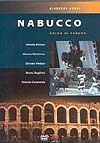 |
| La Scala |
1986 |
Renato Bruson
Riccardo Muti |
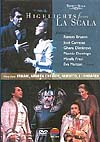 |
| Naples |
1997 |
Renato Bruson
Paolo Carignani |
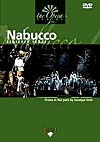 |
| the Met |
2001 |
Juan Pons
James Levine |
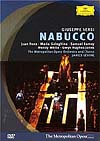 |
| Piacenza |
2004 |
Ambrogio Maestri |
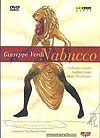 |
An updated version
with Leo Nucci in the title role appeared
in 2006 (to be reviewed)
In one bound Nabucco put Verdi
to the forefront of Italian opera composers.
The salons of the aristocracy were opened
to the country boy. From this period
his long friendships with the Countesses
Appiani, and particularly Maffei, date.
In their salons he mixed with the cognoscenti
of Milanese literature and music, many
of whom were politically radical thinkers.
After Nabucco Verdi never lacked
for commissions. Indeed there were times
that the pressures from impresarios
and publishers became too great and
his health suffered. In the next nine
years he composed thirteen operas for
all the great theatres of Italy as well
as for London and Paris. Verdi was to
call these years his Ďanni de galeraí
(years in the galleys).
With the raging success of Nabucco
on his hands, La Scala impresario
Merelli wanted to get Verdi started
on his next opera. This would be the
last of the three the composer had contracted
for the theatre after the modest success
of Oberto and including the failure
of Un giorno di Regno. Merelli,
recognising Verdiís newfound status
asked him to name his own fee. Uncertain,
the composer sought the advice of Giuseppina
Strepponi who was singing Abigaille
during the run of Nabucco. She advised
him to ask for the same fee as Bellini
was paid for Norma, eight thousand
Austrian Lire. Verdi asked for, and
got, nine thousand!
Verdiís 4th opera, I
Lombardi alla prima crociata
(the Lombards of the first Crusade)
was premiered at La Scala on 11 February
1843. The libretto was again by Solera
and he and the composer seem intent
on a mark two Nabucco. The theme
has a religious basis and there are
plenty of choral frescoes and more than
a hint of patriotic nationalistic fervour
for the audience to identify with. At
the first performance the act 4 chorus
O Signore, dal tetto natioí (O
Lord, give us a native heath) aroused
a storm of approval just as Va pensiero
had done in Nabucco. The opera
also marked an early brush with the
Church and censor. Verdi refused point-blank
to alter what was written and it required
some diplomacy on Soleraís part with
a sympathetic Chief of Police to settle
on the simple change of Ave Maria
to Salve Maria, which Verdi
accepted. Critical opinion regards the
libretto as poorly constructed and full
of improbabilities in a sequence of
scenes that includes a last act aria
from heaven by the slaughtered tenor
hero. Stagings of an opera with eleven
scenes do not come round often.
Significantly a different roster of
singers were available at La Scala for
I Lombardi than those for Nabucco,
notably the soprano Erminia Frezzolini
who had debuted as Belliniís Beatrice
in 1838 and included Donizettiís
Lucia in her repertoire. Verdi
always wanted to know the singers available
before composing and kept their vocal
characteristics in mind while doing
so. The soprano role in I Lombardi
is utterly different from Abigaille
and reflects Frezzoliniís strengths
being lighter, more flexible and pure-toned.
Without doubt these characteristics
also influenced Verdiís conception of
his heroineís personality and is an
important consideration in the casting
of the role in recordings. There is
no baritone role in the opera but as
well as a principal tenor there is a
tenor comprimario role of greater substance
than that definition usually implies.
The casting of this secondary role on
recordings, along with the principal
tenor, bass and soprano is significant
to enjoyment.
Philips launched their series of eight
recordings of early Verdi operas under
Lamberto Gardelli with I Lombardi.
Recorded in London in 1971 it features
the young Placido Domingo in 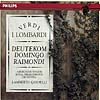 pristine
and virile vocal condition as Oronte.
His stylish singing is well matched
by the sonority and evenness of Ruggero
Raimondi as the later contrite villain
Pagano. In the Frezzolini role of Viclinda,
Christina Deutekom is more variable,
often lacking body to her tone. Jerome
Lo Monaco is an excellent second tenor.
This recording held the field until
in 1996 Decca got round to recording
Pavarotti in a role he had first sung
long before in the theatre. It was recorded
in New York under James Levine with
the Met orchestra and chorus. Although
Pavarotti has lost some of the sap from
his tone and lacks the vocal youthfulness
of Domingo, his is a well-sung interpretation.
Samuel Ramey as Pagano whilst showing
some vocal looseness of tone since his
best days is always musical and characterful.
June Anderson scores over Christina
Deutekom for vocal body but lacks some
flexibility. By the time of the recording
James Levine was a much more sympathetic
Verdian than earlier metronomic self.
Where this version scores highly is
in the immediacy of the recording and
the singing of the Metropolitan Opera
Chorus who are full-bodied and vibrant
(Decca 455 287-2). The secondary tenor
role is well taken by Richard Leech
and the importance of the role is highlighted
by the poor performance of Carlo Bini
on the only currently available DVD
version, that of the 1982 La Scala produ
pristine
and virile vocal condition as Oronte.
His stylish singing is well matched
by the sonority and evenness of Ruggero
Raimondi as the later contrite villain
Pagano. In the Frezzolini role of Viclinda,
Christina Deutekom is more variable,
often lacking body to her tone. Jerome
Lo Monaco is an excellent second tenor.
This recording held the field until
in 1996 Decca got round to recording
Pavarotti in a role he had first sung
long before in the theatre. It was recorded
in New York under James Levine with
the Met orchestra and chorus. Although
Pavarotti has lost some of the sap from
his tone and lacks the vocal youthfulness
of Domingo, his is a well-sung interpretation.
Samuel Ramey as Pagano whilst showing
some vocal looseness of tone since his
best days is always musical and characterful.
June Anderson scores over Christina
Deutekom for vocal body but lacks some
flexibility. By the time of the recording
James Levine was a much more sympathetic
Verdian than earlier metronomic self.
Where this version scores highly is
in the immediacy of the recording and
the singing of the Metropolitan Opera
Chorus who are full-bodied and vibrant
(Decca 455 287-2). The secondary tenor
role is well taken by Richard Leech
and the importance of the role is highlighted
by the poor performance of Carlo Bini
on the only currently available DVD
version, that of the 1982 La Scala produ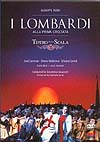 ction.
The vocal strengths in this performance
are provided by José Carreras
as Oronte and Silvano Carroli as Pagano.
As the heroine Ghena Dimitrova is vocally
variable and acts poorly. The production
is traditional with lavishly costumed
Crusaders and Muslims. Brief extracts
are contained on a DVD of scenes from
La Scala stagings from the early 1980s
(see review)
and there is also a recording of the
complete production: La Scala, Milan/Gianandrea
Gavazzeni (see review).
There also exists a live performance
at 'Teatro Ponchielli,' Cremona, Italy.
November 2001 conducted by Tiziano Severini
(see review)
ction.
The vocal strengths in this performance
are provided by José Carreras
as Oronte and Silvano Carroli as Pagano.
As the heroine Ghena Dimitrova is vocally
variable and acts poorly. The production
is traditional with lavishly costumed
Crusaders and Muslims. Brief extracts
are contained on a DVD of scenes from
La Scala stagings from the early 1980s
(see review)
and there is also a recording of the
complete production: La Scala, Milan/Gianandrea
Gavazzeni (see review).
There also exists a live performance
at 'Teatro Ponchielli,' Cremona, Italy.
November 2001 conducted by Tiziano Severini
(see review)
The success of Nabucco and I
Lombardi placed Verdi at the forefront
of Italian opera composers of his generation.
Offers of contracts from around Italy
poured in. Whilst recognising his indebtedness
to impresario Merelliís support, the
composer resisted his blandishments
for another opera for La Scala. Maybe
Verdi was reluctant to push his luck
with another premiere at Italyís leading
House, or perhaps he wished to dip his
toes into other waters. There was also
the matter of his relationship with
the experienced but rather slapdash
librettist Solera. Verdi had a very
acute sense of theatre and felt restricted
by his librettistís rather casual off
the peg approach. Given Soleraís experience,
Verdi did not constantly press for more
apt dramatic situations as he did subsequently
with other librettists.
Meanwhile the Society that owned the
Gran Teatro la Fenice in Venice assembled
to decide on the names of opera composers
for the coming season with Verdi high
on the list. La Fenice was La Scalaís
biggest rival in Northern Italy. Rossini
had won international fame with Tancredi
and LíItaliana in Algeri,
both premiered at the Fenice and concluded
his Italian career in triumph with Semiramide
premiered on 3 February 1823. After
that performance Rossini was escorted
to his lodgings by a flotilla of gondolas,
a water-borne band playing a selection
from his score. A success in Venice
had its own particular flavour and the
prospect was an attraction for Verdi.
Count Alvise di Mocenigo, president
of La Fenice, entered into correspondence
with Verdi, much of which survives.
The composer, aware of his increasing
value drove a hard bargain asking for
twelve thousand Lire for the new opera,
the fee to be paid after the first performance,
not as was usual after the third. After
all if the opera was not well received
there might not be a third. Verdi also
demanded that La Fenice stage I Lombardi
as well as presenting a new opera
to a libretto of the composerís choice.
To write the verses he chose Francesco
Maria Piave who was to be his collaborator
in many subsequent works.
Piaveís name was suggested to Verdi
by the management of La Fenice as a
good versifier. He was almost the same
age as the composer but had never previously
written for the theatre. He and Verdi
were ripe for each other. Although Piaveís
verses were well crafted Verdi constantly
demanded changes, making suggestions
that would give greater dramatic effect.
The librettist was happy with this modus
operandi throughout their long association
that extends through Macbeth and
Rigoletto to the original 1862
version of La forza del destino,
and its 1869 revision, ten operas in
all.
As well as wanting to work with a more
malleable librettist than Solera, Verdi
also wanted to break away from the latterís
grand frescoes and move towards the
setting of more intimate and personal
dramas. After turning down one libretto
from Piave he settled on the subject
of Ernani as his 5th
opera. Based on Victor Hugo, it
featured Verdiís first bandit or outlaw
character. This feeling for the outsider
might reflect something of his introspective
view of himself and his origins. It
is noticeable in later life how he tended
to shelter his own beginnings and the
bruises he sustained along his way to
success.
Although the subject of Ernani had
already been featured in operas by others,
and even considered by Bellini, Verdiís
music brought out the story as no other
had done before. Verdiís Ernani is
written in traditional form with arias,
cabalettas and group scenes with virile
chorus contributions an additional attraction
for composer and audience. Verdi brings
out the character of the conflicting
roles, and their various relationships,
so that each has clear identification
in the music. This manner had, perhaps,
been missing in his earlier successful
duo, which had succeeded on the basis
of the popular appeal their thrusting
melodies and identification with the
frustrations and aspirations of the
audience. Ernani has a density
of musical invention and melody that
is perhaps only matched by Macbeth
before being equalled in Rigoletto,
all with libretti by Piave, and the
great mature period operas that followed.
As with the earlier performances of
I Lombardi in Venice, Ernani
had only a moderate success at its
premiere, the vocal limitations of some
of the soloists being to blame. It had
to wait until felicitous productions
at Vienna in May 1844, and La Scala
in September of that year, for full
recognition of its qualities. For the
La Scala performances additions were
made to the role of Silva with an added
cabaletta in act one to accommodate
the distinguished bass of the time and
promote the role from comprimario to
primo basso. Ernani was the first
of Verdiís operas to be translated into
English and was admired by George Bernard
Shaw. It remained in the Italian repertoire
in Verdiís lifetime, eventually falling
from favour in the early part of the
twentieth century.
In view of the musical invention and
vibrancy of Ernani, including
the melodic arias for all the principals
and some magnificent choruses, the paucity
of recorded versions is surprising.
It perhaps reflects the intellectual
elitism towards early Verdi that was
prevalent among opera house intendants
and some artist and repertoire departments
of recording companies in the heyday
of recorded opera. A 1967 studio recording
made in Rome with Bergonzi as Ernani
and Leontyne Price as Elvira displaced
an early 1950s Cetra issue. It remains
the best-sung version although the recording
has its rough edges (RCA). An atmospheric
1982 Hungaroton recording features a
vibrant Sylvia Sass and a tightly focused
Ernani from Giorgio Lamberti. 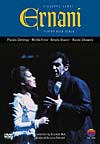 This
is now available at mid price (Philips)
but has little to commend it apart from
Gardelliís conducting. A 1982 live La
Scala performance is vibrantly and dramatically
played under Muti and has a starry cast
of Bruson, Ghiaurov, Domingo and Mirella
Freni in the principal roles (EMI on
CD and Warner DVD). Bruson and Domingo
are in superb voice whilst Ghiaurov
sounds suitably authorative as the inflexible
Silva. In the large La Scala theatre,
Freniís voice is a size too small and
she sounds strained at times. Add the
difficult acoustic of La Scala and the
fact that the audio recording is spread
over three CDs and a firm recommendation
in this medium falls on the RCA issue.
The most recent original language audio
recording features the final collaboration
on record of Joan Sutherland and Pavarotti
with support from Nucci and
This
is now available at mid price (Philips)
but has little to commend it apart from
Gardelliís conducting. A 1982 live La
Scala performance is vibrantly and dramatically
played under Muti and has a starry cast
of Bruson, Ghiaurov, Domingo and Mirella
Freni in the principal roles (EMI on
CD and Warner DVD). Bruson and Domingo
are in superb voice whilst Ghiaurov
sounds suitably authorative as the inflexible
Silva. In the large La Scala theatre,
Freniís voice is a size too small and
she sounds strained at times. Add the
difficult acoustic of La Scala and the
fact that the audio recording is spread
over three CDs and a firm recommendation
in this medium falls on the RCA issue.
The most recent original language audio
recording features the final collaboration
on record of Joan Sutherland and Pavarotti
with support from Nucci and  Burchuladze
under Bonynge now at mid price (see
review).
Made in 1987 it sat in Deccaís vaults
for eleven years before seeing the light
of day. The reason is not difficult
to determine as one listens to the tenorís
tentative start, the divaís poor diction
and lack of steadiness in Ernani
involami, Nucciís nasal sound and
the glottal Italian of Burchuladze.
In fairness, Pavarotti improves to give
a worthy and at times thrilling performance.
The latest studio recording is that
on Chandosí Opera In English
series with Alan Opie commendable as
the King (reviewed
in live performance) On DVD the La Scala
performance under Muti is available
from Warner in a resplendent production
by Luca Ronconi. Excerpts from this
issue featuring all the principals can
be seen on a Warner La Scala highlights
DVD (see review).
Burchuladze
under Bonynge now at mid price (see
review).
Made in 1987 it sat in Deccaís vaults
for eleven years before seeing the light
of day. The reason is not difficult
to determine as one listens to the tenorís
tentative start, the divaís poor diction
and lack of steadiness in Ernani
involami, Nucciís nasal sound and
the glottal Italian of Burchuladze.
In fairness, Pavarotti improves to give
a worthy and at times thrilling performance.
The latest studio recording is that
on Chandosí Opera In English
series with Alan Opie commendable as
the King (reviewed
in live performance) On DVD the La Scala
performance under Muti is available
from Warner in a resplendent production
by Luca Ronconi. Excerpts from this
issue featuring all the principals can
be seen on a Warner La Scala highlights
DVD (see review).
On his return to Milan after the Venice
production of Ernani, Verdi found
himself offered contracts to write for
several Italian theatres. He was seen,
aged thirty, as the coming composer
and natural successor to Donizetti.
He was to write ten operas in the remainder
of the decade and to call these years
his ‘anni de galera’ (galley
years). These operas, which were premiered
in Paris and London as well as throughout
Italy, are the subject of Part
2 of this conspectus.
Robert J Farr
Go to: Part
2 Part
3 Part 4

